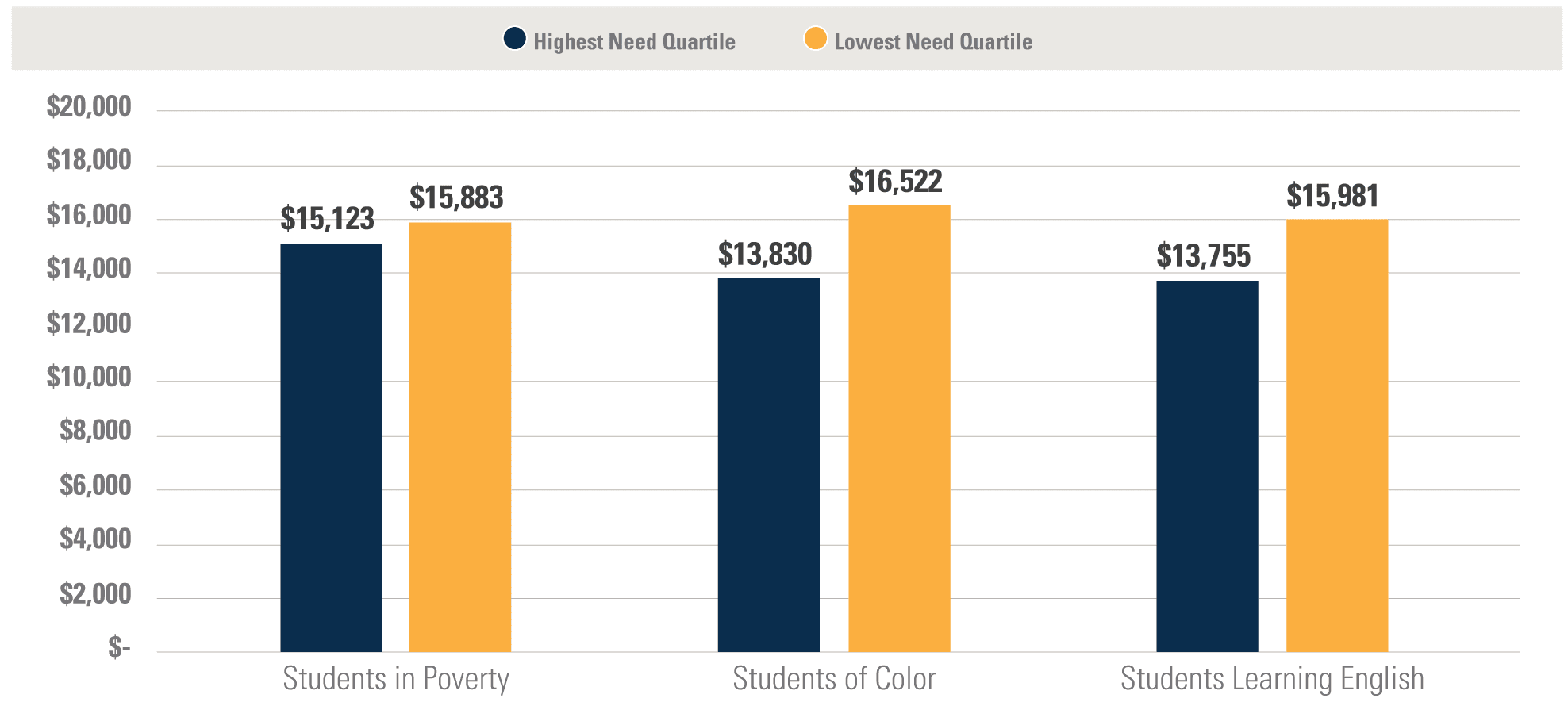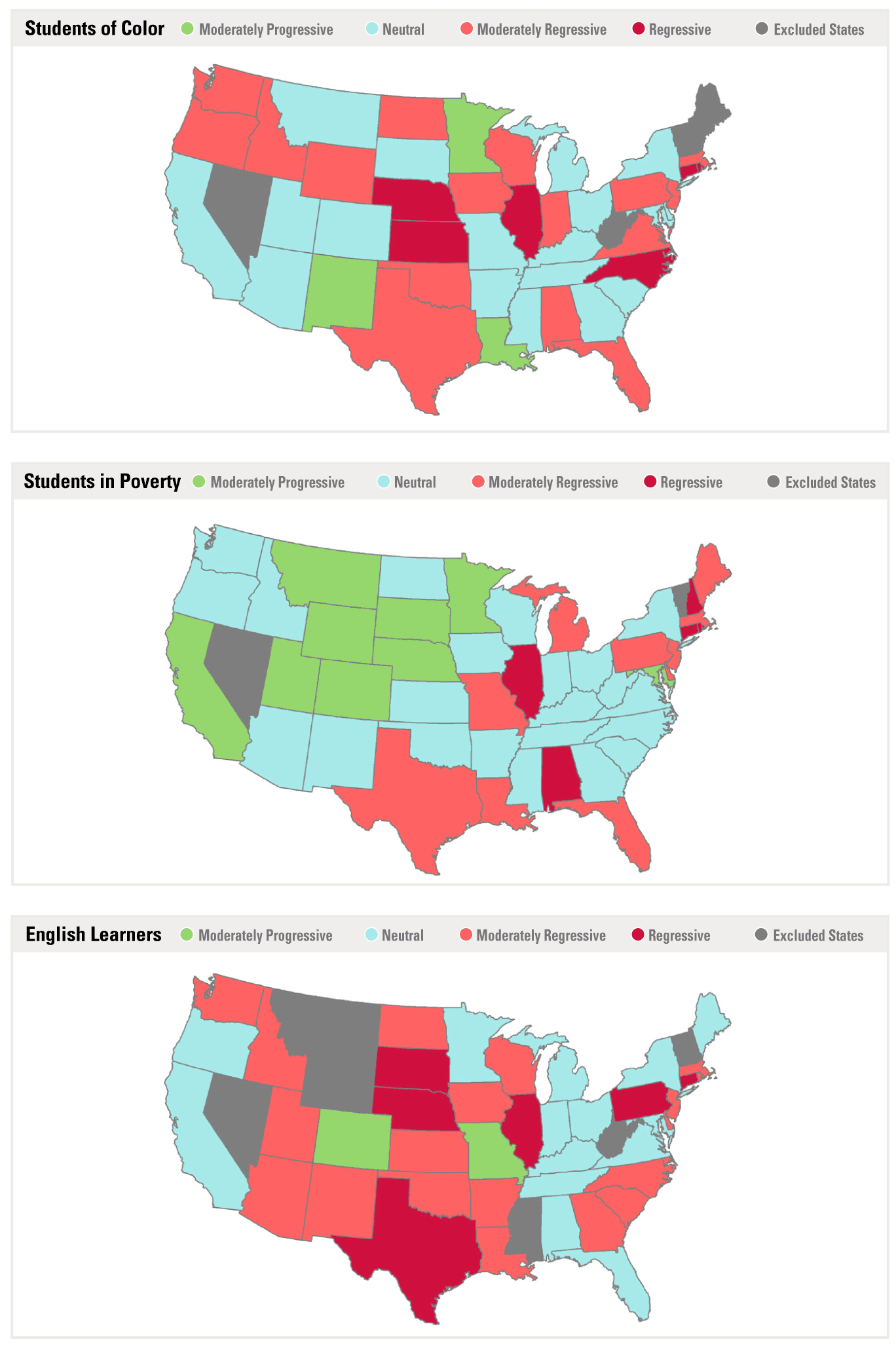Equal is not Good Enough: ADVOCACY BRIEF
ADVOCACY BRIEF
When it comes to providing children with a high-quality education, money matters. Research shows that sustained and significant increases in school funding can have a lasting positive impact on student achievement and other outcomes — especially for students from low-income backgrounds. Yet, the U.S. education system is plagued with persistent and longstanding funding inequities — with the majority of states sending the fewest number of resources to the districts and schools that actually need the most resources. As a result, millions of students are not getting the proper resources that would allow them to succeed.
WHAT DID WE FIND?
Accompanied by a new, interactive data tool that, for the first time, drills down to district and specific school data, this updated analysis of school funding equity between districts in states reveals several noteworthy findings:
- Across the country, districts with the most students of color on average receive substantially less (16%) state and local revenue than districts with the fewest students of color, and high-poverty districts receive 5% less state and local revenue than low-poverty districts.
- In a new analysis that compares funding between the country’s districts with the most and fewest English learners, districts with the most English learners receive 14% less state and local revenue, compared with districts with the fewest English learners.
- Disappointingly, the gaps in state and local revenue between districts with the most and fewest students of color or English learners tend to be worse than the poverty-based gaps.
State and Local Revenues per Student between Districts Serving the Most and Fewest Students, by Student Group (2018-2020)

Reading this figure: On average, the districts with the most students in poverty received $15,123 per student in state and local revenue, compared to $15,883 received by districts with the fewest students in poverty.
- While national summary data shows clear regressive funding patterns, state-by-state data tells a more nuanced story, where state funding gaps vary widely in direction and magnitude; and states that are allocating revenue progressively for one group of students aren’t necessarily doing that for other groups.
Gaps in State and Local Revenues per Student between Districts Serving the Most and Fewest Students, by Student Group (2018-2020)

For more details, including state-by-state data, see the full report and our new interactive school funding gaps data tool, which allows comparison both between and within districts.
WHAT SHOULD ADVOCATES DO?
Research shows that districts need more school funding — not equal, and certainly not less — especially to provide significant resources that support the needs of English learners and students from low-income backgrounds. In addition, underserved students should have access to at least as much school funding and as many high-quality resources as their peers. Given this, states and districts have a long way to go to achieve school funding equity.
The funding gaps revealed in this report can lead to so many other inequities in schools — like the ability to pay teachers more, which can help attract strong, more experienced educators; or to provide underserved students with additional supports and enrichment opportunities.
This analysis shows clearly that state leaders have a lot of work to do to close gaps in school funding between high- and low-need districts. Here are some ways that advocates can push state leaders to effect change:
- Share findings about funding gaps — between districts in your state, and/or how your state compares with other states — with state education leaders. Urge state leaders to consider how the structure and components of the state’s funding formula contribute to these challenges, and whether there are other resource challenges related to these inequities.
- Share these findings with community advocates, families, and other stakeholders invested in fiscal equity in their states or districts. This report can help answer questions about spending equity and help make the case for fairer and additional school funding, protect high-need districts from budget cuts, and eliminate funding inequities.
- Understand your state’s school funding system through the interactive data tool FundEd and investigate whether your state prioritizes providing additional resources to support students from low-income backgrounds, English learners, and other student groups, or to districts with less ability to raise local revenue. Also, review your state’s local revenue policies to see whether your state places guardrails around how much districts must or may raise for education to understand whether local revenue disparities are likely to be a major driver of inequities.
- Learn about what features your state’s funding system should include in 5 Things to Advance Equity in State Funding Systems and Common Sense & Fairness, and build a model funding formula with EdBuilder that includes all of the features and priorities that are important in your state.
- Look for opportunity windows that might improve the chances of successful school funding reform, such as:
- Litigation and court rulings that require the state to revise the school funding system
- Commissions that are charged with reviewing and proposing changes to the existing funding system
- State budget events, such as surpluses or infusions of federal aid
- Encourage your state to adopt policies that advance equity in school funding systems, based on the specific patterns of inequity that exist in your state’s funding system.
